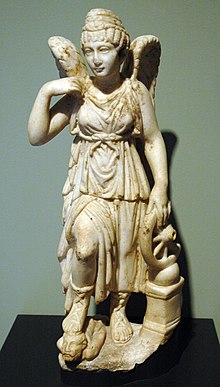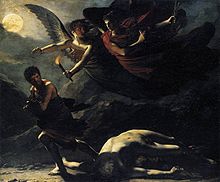Nemesis
Nemesis ( Greek Νέμεσις Némesis , German 'allotment (of the due)' ) is in Greek mythology the goddess of righteous anger , of equalizing justice , which made her the deity of revenge .
Your companion is Aidos , the goddess of shame . Above all, Nemesis punishes human overestimation of oneself ( hubris ) and disregard for Themis , (the goddess) of divine law and morality .
In the late 20th century, the influence of pop culture brought about a change in meaning in the sense of an eternal adversary , an arch rival , a kind of personal angel of death , a mortal enemy, a non-personified deathbringer or a deadly threat. The statement "I am your nemesis" is interpreted as "I am your doom" instead of "You get what you deserve".
myth
She is a daughter of Nyx ("night"), either born out of it, or the daughter of Nyx and Erebos , or daughter of Oceanus .
Zeus mated with Nemesis in the form of a swan , after initially fleeing his stalkings out of shame and righteous anger. On her flight across the sea, she turned into a fish, arrived at the edge of the earth, finally into a duck or goose, with whom Zeus, as a swan, fathered Helena , for whose sake the Trojan War was finally waged .
In another version of the story, Aphrodite plays the nemesis to Zeus by pouncing as an eagle on the swan, which can "take refuge" in the lap of the nemesis. In both stories, the egg is brought to Leda , who is raising Helena - although she is not Helena herself. Swan and eagle became the corresponding constellations.
According to Bakchylides , Nemesis with Tartaros is the mother of the Telchines of Rhodes .
In Ovid's Metamorphoses , she punishes Narcissus for having ruined the nymph Echo and others with his inexorability.

Its attributes are manifold. Among other things, she holds a branch from the apple tree in her hand and is accompanied by a griffin . Like the Erinys or Furies, it can also be invoked in the plural ( Nemeseis ). Two Nemeseis were venerated in Smyrna , who appeared to Alexander the Great in a dream at the local sanctuary when he slept under a plane tree , exhausted from the hunt : They asked him to re-establish the city of Smyrna, where their oldest cult site was. The oracle of Apollo at Klaros confirmed the order.
In Aeschylus ' The Fettered Prometheus , Nemesis is also called Adrasteia ("the inevitable"), in Ovid's Metamorphoses Rhamnusia after her sanctuary with the famous cult image in Rhamnous .

The Orphic hymn "An Nemesis" makes it clear that, in contrast to modern understanding, the goddess Nemesis is more of a judge than an avenger :
I call you, nemesis!
Highest!
Divinely reigning queen!
All-seeing ones, you survey
The multi-stemmed mortals' lives.
Eternal, saints, your joy
are only the righteous.
But you hate the speech glass,
the colorful, shimmering, always wavering,
which people shy away from,
who
bowed their necks to the pressing yoke .
You know all people's opinions,
and your soul never withdraws
haughty and proud of
the blurry flood of words.
You look into
everything, listening to everything, everything decisive.
Yours is the judgment of men.
[...]
Friedrich Schiller writes:
"It is the deity, who is capable of good-sounding, / who arranges the raging leap for sociable dance, / who, like nemesis, on the rhythm of the golden reins / guides the roaring lust and tames the wild."
astronomy
The main belt asteroid (128) Nemesis , discovered in 1872, was named after the goddess.
In addition, Nemesis is the name of a hypothetical celestial body that would turn the solar system into a binary star system . The hypothesis was put forward by David M. Raup and J. John Sepkoski in 1984 when they analyzed previous mass extinctions. In doing so, they discovered that these occur at intervals of around 27 million years. As an explanation, they postulated a companion star of the sun, which at this time crossed the Oort cloud and thus directed more comets and asteroids into the solar system than usual. Alternatively, this was also explained by a planet ( Tyche ). More recent findings contradict both hypotheses.
literature
- Hans Herter : Nemesis. In: Paulys Realencyclopadie der classischen Antiquity Science (RE). Volume XVI, 2, Stuttgart 1935, Col. 2338-2380.
- Paulina Karanastassis, Federico Rausa: Nemesis . In: Lexicon Iconographicum Mythologiae Classicae (LIMC). Volume VI, Zurich / Munich 1992, pp. 733-770.
- Noel Deeves Robertson: Nemesis. The history of a Social and Religious Idea in Early Greece. Ithaca NY 1964, OCLC 638349797 (Philosophical Dissertation, Cornell University, Ithaca NY, 1964).
- Otto Rossbach : Nemesis . In: Wilhelm Heinrich Roscher (Hrsg.): Detailed lexicon of Greek and Roman mythology . Volume 3.1, Leipzig 1902, Sp. 117-166 ( digitized version ).
- Mary Scott: Aidos and Nemesis in the Works of Homer, and their relevance to Social or Co-operative Values. In: Acta Classica. Vol. 23, No. 1, 1980, ISSN 0065-1141 , pp. 13-35, ( digital version (PDF; 1.54 MB) ).
- Jan Stenger : Nemesis. In: The New Pauly (DNP). Volume 8, Metzler, Stuttgart 2000, ISBN 3-476-01478-9 , column 818 f.
- Hermann Posnansky: Nemesis and Adrasteia. A mythological-archaeological treatise (= Breslauer philological treatises. Volume 5, Issue 2, ISSN 0866-9155 ), Koebner, Breslau 1890, ( digitized version ).
- Marion Tradler: The Iconography of the Nemesis. Mainz 1998 DNB 959198660 Dissertation, University, Mainz, 1998
- Fiction
- Translator Irene Holicki: Isaac Asimov , Nemesis. Heyne, Munich 1989 and others
Web links
- Nemesis in the Theoi Project (English)
- Nemesis votive relief from the amphitheater of Virunum
- Nemesis , in: The large art dictionary by PW Hartmann
Individual evidence
- ↑ Hesiod Theogony 233. Pausanias 7,5,3
- ^ Hyginus Mythographus Fabulae praefation. Cicero De Natura Deorum 3.17
- ↑ Pausanias 7,5,3. Nonnos Dionysiaka 48,375. Johannes Tzetzes to Lycophron 88
- ↑ Kypria Frag. 8. Libraries of Apollodorus 3,127. Pausanias 1,33,4
- ^ Hyginus Mythographus Astronomica 2.8
- ↑ Bakchylides Frag. 52
- ↑ Ovid 's Metamorphoses 3,406
- ↑ Pausanias 7,5,1ff
- ↑ Orphic Hymns 62. Quoted from: Orpheus. Ancient Greek mysteries , trans. and ext. by Joseph Otto Plassmann, Diederichs Yellow Row , Cologne 1982, p. 103. Plassmann (1895-1964), Vita: 1936-1943, chief editor of the magazine "Germanien. MONTHLYhefte für Germanenkunde"; 1936, department head " Race Office " in the Race and Settlement Main Office of the SS ; 1937, head of the teaching and research facility for Germanic cultural studies and landscape studies in the SS-Ahnenerbe ; 1943, lecturer in German studies and Nordic philology, University of Tübingen ; 1944-1946, associate professor for German folklore , University of Bonn .
- ^ Marc Davis, Piet Hut, Richard A. Muller, Nature, April 1984, pp. 715 ff.
- ^ Marc Davis, Piet Hut, Richard A. Muller, Nature February 1985, p. 503
- ↑ Anatol Johansen: Giant Planet Tyche - mysterious and overlooked. In: welt.de. February 18, 2011, accessed August 23, 2019 .
- ↑ Ralph-Mirko Richter: WISE: No planet X in the outer solar system. In: raumfahrer.net. March 11, 2014, accessed April 12, 2018 .

